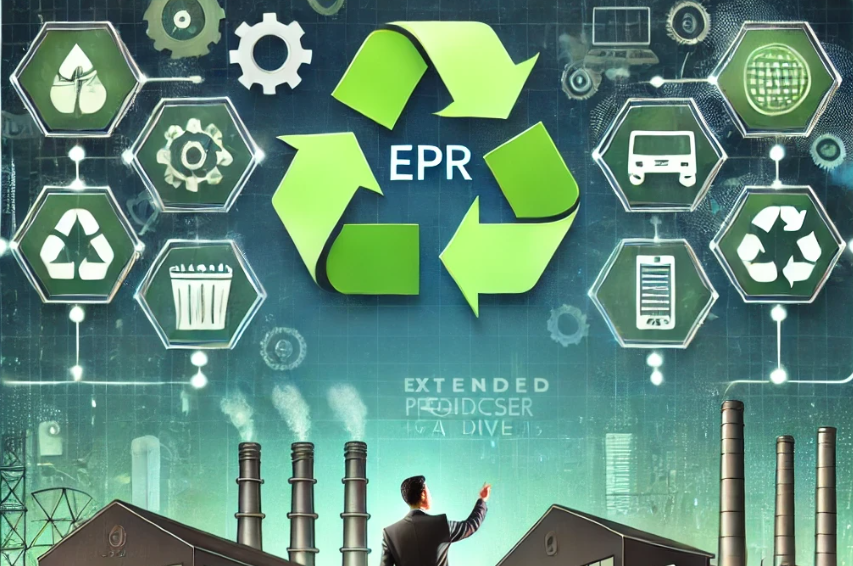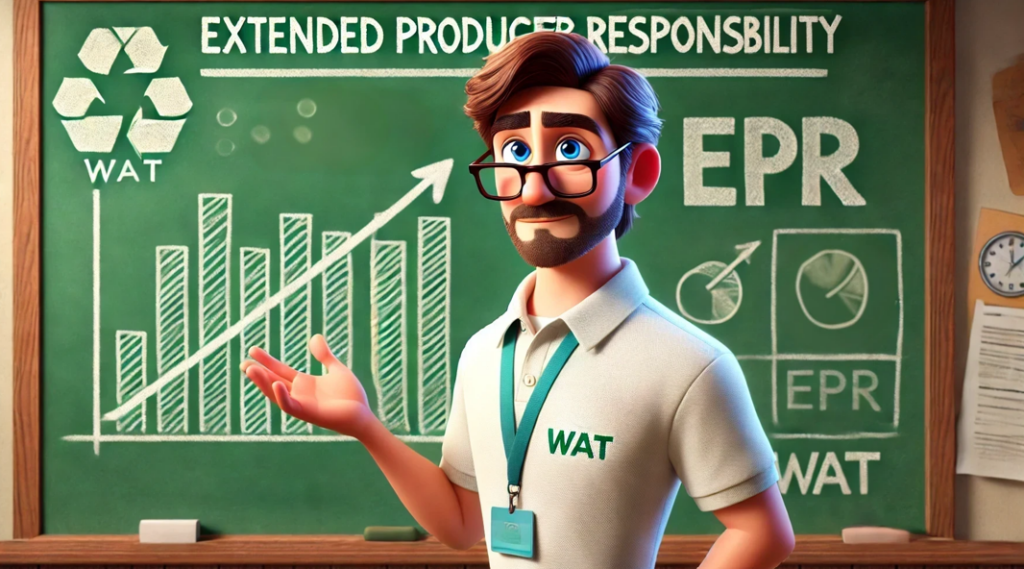E-waste, or electronic waste, is one of the fastest-growing waste streams in the world. As technology advances rapidly, so does the need to manage the mountains of discarded electronic devices that no longer serve their purpose. Extended Producer Responsibility (EPR) has emerged as a crucial policy tool to tackle this issue by placing the responsibility for the end-of-life management of products onto manufacturers. This article will try to explain the concept of EPR, its global impact, and its role in creating a circular economy.

1. What is Extended Producer Responsibility (EPR)?
Extended Producer Responsibility is a policy principle that holds manufacturers accountable for the entire lifecycle of their products, including take-back, recycling, and final disposal. EPR shifts the financial and physical responsibility from municipalities and consumers to the producers, incentivizing eco-friendly designs and sustainable waste management.
2. The Importance of EPR in E-Waste Management
E-waste contains hazardous materials such as lead, mercury, and cadmium, which can be harmful to human health and the environment. EPR helps address these concerns by encouraging producers to design products that are easier to recycle and dispose of safely. By holding manufacturers responsible for the environmental impact of their products, EPR also fosters innovation in product design and manufacturing processes.

3. The Global Landscape of EPR
Countries around the world have adopted EPR policies in various forms. In Europe, the Waste Electrical and Electronic Equipment (WEEE) Directive is a well-known example of EPR in action. In North America, several states and provinces have introduced their own EPR laws, though the approach varies widely. Emerging markets such as India and Brazil are also adopting EPR legislation to cope with their growing e-waste challenges. In UAE the Ministry of Climate change and Environment (MOCCAE) is drafting the implementation of EPR for end of 2025.
4. Challenges and Opportunities
One of the biggest challenges for EPR implementation is the lack of harmonization across countries. Different definitions, obligations, and reporting requirements make it difficult for multinational companies to comply with EPR regulations. On the other hand, EPR presents opportunities for innovation in recycling technologies and business models. Companies can develop new ways to recover valuable materials from e-waste and reduce the environmental impact of their products.

5. The Role of Consumers and Other Stakeholders
While EPR places most of the responsibility on producers, consumers and other stakeholders play a vital role in the success of the system. Consumers must be educated about proper e-waste disposal and incentivized to return their used electronics. Governments, non-governmental organizations (NGOs), and the informal sector also have a role to play in supporting e-waste collection and recycling efforts.

A Path Towards a Circular Economy
EPR is more than just a policy tool—it is a step towards creating a circular economy where products are designed with their entire lifecycle in mind. By encouraging sustainable product design and responsible waste management, EPR can help reduce the environmental impact of e-waste and create a cleaner, healthier planet for future generations.
Case Studies in EPR Implementation
Several countries have successfully implemented EPR programs with varying degrees of success. One notable example is France, where e-waste management is governed by robust systems that involve multiple stakeholders, including local authorities, manufacturers, and specialized eco-organizations. As seen in France’s e-waste management framework, collection and recovery systems are coordinated through approved eco-organizations such as Ecosystems, EcoLogic, and the European Recycling Platform (ERP). These organizations ensure that manufacturers and importers contribute financially to the collection, treatment, and recycling of e-waste in compliance with EU regulations.
A key lesson from France’s experience is the necessity of clear stakeholder roles and comprehensive regulatory frameworks that incentivize producers to adopt sustainable product designs. For example, producers pay fees based on the design of their products, with additional incentives for those who prioritize ease of dismantling and the recyclability of materials.
In contrast, developing countries often struggle with EPR implementation due to weaker regulatory enforcement and the prevalence of informal recycling sectors. Case studies from countries like India and China highlight the challenges of integrating informal recyclers into formal systems while managing hazardous substances effectively. Both nations are making strides by introducing stricter regulations, but significant gaps in collection infrastructure and public awareness remain.
Global Harmonization of EPR Policies
As global e-waste production continues to rise, harmonizing EPR policies across borders is becoming increasingly critical. This is especially important because e-waste often crosses international boundaries, either legally or illegally, creating global challenges in its management. The European Union has set a benchmark with its WEEE (Waste Electrical and Electronic Equipment) Directive, which mandates minimum collection and recycling targets for member states. The EU model could serve as a foundation for a global framework, particularly for regions where e-waste management policies are still emerging.
One of the potential benefits of harmonization is the reduction in illegal e-waste exports, particularly to countries with weaker environmental protections. By creating uniform standards, countries can ensure that hazardous materials are treated responsibly and that valuable materials like gold, copper, and aluminum are recovered efficiently, reducing the need for primary resource extraction.
However, global harmonization faces challenges. Countries vary widely in their regulatory environments, levels of technological development, and economic capacity to enforce such policies. Collaboration through international bodies such as the Basel Convention (ban.org) and regional trade organizations could help facilitate policy convergence, with high-income nations offering financial and technical support to lower-income countries to develop compliant systems.
Economic and Environmental Benefits of EPR
The successful implementation of EPR policies yields substantial economic and environmental benefits. From an economic perspective, EPR promotes innovation in product design, encouraging manufacturers to create electronics that are easier to dismantle, repair, and recycle. This leads to cost savings throughout the product lifecycle. For instance, companies that embrace circular economy principles can reduce raw material costs by reusing components recovered from e-waste.
EPR policies can create new job opportunities in the recycling and refurbishment sectors. In France, the establishment of e-waste collection and treatment centers has not only contributed to environmental goals but also boosted local economies by creating green jobs. These centers recover valuable materials, such as ferrous metals, plastics, and rare earth elements, that can be reintegrated into manufacturing supply chains.
Environmentally, the benefits are clear. EPR reduces the volume of e-waste sent to landfills and incinerators, where harmful chemicals like mercury, lead, and cadmium can leach into the soil, water and air. By promoting recycling and resource recovery, EPR helps to conserve natural resources, reduces energy consumption, and mitigates greenhouse gas emissions. For example, recycling metals like aluminum and copper consumes significantly less energy than extracting them from raw ores, leading to lower carbon footprints.
The global adoption and harmonization of EPR policies have the potential to significantly reduce the environmental impact of e-waste, conserve valuable resources, and stimulate green economic growth. By learning from successful case studies and addressing the challenges faced by developing nations, the global community can work toward more sustainable e-waste management practices.
